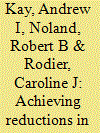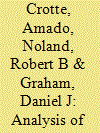| Srl | Item |
| 1 |
ID:
132687


|
|
|
|
|
| Publication |
2014.
|
| Summary/Abstract |
It is well established that GHG emissions must be reduced 50 to 80% by 2050 in order to limit global temperature increase to 2 °C. Achieving reductions of this magnitude in the transportation sector is a challenge and requires a multitude of policies and technology options. The research presented here analyzes three scenarios: changes in the perceived price of travel, land use intensification, and increases in transit. Elasticity estimates are derived using an activity-based travel model for the state of California and broadly representative of the US. The VISION model is used to forecast changes in technology and fuel options that are currently forecast to occur in the US for the period 2000-2040, providing a life-cycle GHG forecast for the road transportation sector. Results suggest that aggressive policy action is required, especially pricing policies, but also more on the technology side, especially increases in the carbon efficiency of medium and heavy-duty vehicles.
|
|
|
|
|
|
|
|
|
|
|
|
|
|
|
|
| 2 |
ID:
097346


|
|
|
|
|
| Publication |
2010.
|
| Summary/Abstract |
The majority of evidence on gasoline demand elasticities is derived from models based on national data. Since the largest growth in population is now taking place in cities in the developing world it is important that we understand whether this national evidence is applicable to demand conditions at the local level. The aim of this paper is to estimate and compare gasoline per vehicle demand elasticities at the national and local levels in Mexico. National elasticities with respect to price, income, vehicle stock and metro fares are estimated using both a time series cointegration model and a panel GMM model for Mexican states. Estimates for Mexico City are derived by modifying national estimates according to mode shares as suggested by Graham and Glaister (2006), and by estimating a panel Within Groups model with data aggregated by borough. Although all models agree on the sign of the elasticities the magnitudes differ greatly. Elasticities change over time and differ between the national and local levels, with smaller price responses in Mexico City. In general, price elasticities are smaller than those reported in the gasoline demand surveys, a pattern previously found in developing countries. The fact that income and vehicle stock elasticities increase over time may suggest that vehicles are being used more intensively in recent years and that Mexico City residents are purchasing larger vehicles. Elasticities with respect to metro fares are negligible, which suggests little substitution between modes. Finally, the fact that fuel efficiency elasticities are smaller than vehicle stock elasticities suggests that vehicle stock size, rather than its composition, has a larger impact on gasoline consumption in Mexico City.
|
|
|
|
|
|
|
|
|
|
|
|
|
|
|
|